
|
The Granite Lake Reservoir Rant by Richard L. Howey, Wyoming, USA |
About 30 miles to the north east of Laramie, nestled in the mountains is Granite Lake which is a major water supply for the city of Cheyenne. The reservoir is located in Curt Gowdy State Park and provides boating, water-skiing, camping, fishing, hiking, and there is even an archery range back in a clearing in the forest. The view of the lake below as one enters the park is truly splendid–a marvelous recreation area. What’s wrong with this picture? I’ll try to keep my response brief–under 100 pages. 1) All of these amenities attract too many people. A problem regarding the entire planet Earth. 2) Piers and concrete boat ramps have been constructed which, in my view, detract from the beauty of the lake. If people want to launch a boat, let them wade through the sand and mud! 3) If it were up to me, I would ban power boats. If we want a society of slim, trim people, then let them row! Furthermore, there is the noise and pollution and the ego games as to who has the biggest, fastest, and noisiest boat. 4) Most of the people are driving large pickup trucks, SUVs, campers, or recreational vehicles the size of Greyhound buses and many of them are hauling boats. Some of these larger vehicles are outfitted with connection for electricity and water, have television sets, computers, and all of the amenities of home. So my question is: Why don’t they stay home?! Teenagers driving fast and powerful boats around a lake, while talking on a cellphone make me nervous. People have a tendency to set up their camps right at the spots where all the best collecting areas are. I think the park service should put up some signs at some of these areas which read:
RESERVED FOR
AQUATIC BIOLOGISTS
FROM 8:00 A.M. TO 5:00 P.M.
However, that isn’t going to happen and so I have to be brazen and go marching through the middle of campsites carrying my nets and collecting bottles, smiling confidently and waving in a friendly fashion, hoping that none of them have Mastiffs or Rottweilers.
Occasionally, an inquisitive young child will wander down to the lake shore and pepper me with questions. I wait until the parents aren’t watching and then push him into the lake. (Just kidding.) Sometime such a child manifests a genuine curiosity and then I try to explain carefully what I am doing and why, but generally these children have very short attention spans, get bored quickly, and wander off.
Almost always when I am outside of the house, I walk with a cane due to a back injury. However, trying to use a cane and carry collecting bottles, nets, etc. is quite awkward and so I devised a net that also serves as a walking stick. I bought a metal shower curtain pole which can be made longer or shorter by rotating one of the two interlocking halves and I then attached the handle of a small, fine-meshed net to one end using plastic-coated wire. So, now I have a walking pole to help me get up and down hills and embankments and the pole also telescopes to let me reach out about 6 feet into the lake or pond. Another piece of gear which I carry with me is a “claw”; this is a 3 foot wooden rod, with two plastic-coated, flat, slightly-curved, metal tines about 6 inches long. They are connected to each other at the bottom of the wooden rod by a metal plate. The plate has a metal rod that runs up parallel to the wooden rod to a handle which opens and closes the “claw”.

These used to be common in homes and shops for reaching object on shelves without having to get up on a stool or ladder. What do I want with such a device on a collecting trip? Well, since it is difficult for me to bend down to fill my collecting jar with water, I simply put it in the claw, dip it in the water at the edge, pull it back up, use my pole net to sweep and then empty it into the jar of water. The process is eccentric enough in its appearance that it does tend to keep adults away.
Why go to all this bother with Granite Lake you might ask, surely there are other lakes and ponds around? Of course, you would be right. However, as those of you who collect water samples well know, almost every lake and pond has its own unique characteristics, flora, and fauna. The first time I encountered Granite lake was on a lovely, early summer afternoon some years ago when my wife and I had decided to go for a drive in the mountains. The air was warm, but not hot, with a light breeze which kept the mosquitoes away and the wildflowers were at their peak–larkspur, gentians, wild orchids, elephant’s head, Indian paintbrush, penstomen, dame’s rocket, fireweed, yarrow and on and on. The lake is deep and much of the walls and the bottom are indeed granite. The water is very clear and I thought to myself—not worth wasting any time on in terms of collecting samples, just enjoy the day. However, my wife, always wiser than I, said: “As long as we’re here you might as well take a few samples.” As it happens, I keep some nets and collecting jars in the trunk of my car always ready should a lovely pond present itself. So, we stopped at 3 places around the lake and I took 2 samples at each. “O frabjous day! Callooh! Callay!' He chortled in his joy...”
One of the greatest delights for an aquatic biologist is to encounter organisms he or she has never seen before. After examining my samples, I began to develop the view that medium-sized lakes are often rather neglected. Local ponds are always an attraction and the “great” lakes, such as the Great Lakes, Baikal, Victoria, etc. are a magnet for professionals as well as amateurs. So, I was delighted to find that the my samples from Granite Lake, in spite of my initial skepticism, contained a splendid variety of organisms, including a number which I had never seen before. The dazzling colonial rotifer Conochilus unicornis was completely new to me. Another rotifer which was new to me was one which I dubbed the “jumping rotifer”, Polyarthra. It uses the feather-like processes on the sides of the body to spring from one point to another. And, of course, there were both familiar and new ciliates, flagellates, desmids, diatoms and algae. I even found some wonderful, large specimens of Amoeba proteus which I managed to culture for over a year. Contrary to popular opinion, the organism is not common in nature, but fortunately it cultures readily and so biological supply houses can supply it at any time of the year.

In over 60 years of poking around ponds, lakes, streams, and rivers, this is the only time, to my knowledge, that I have ever collected it.
I discovered that over the hill to the east, only about 3 miles away, was a second lake–Crystal lake which I decided to visit on my next outing a couple of weeks later. The area surrounding it is considerably less developed than Granite Lake and so it tends to attract fewer people, mostly casual fishermen looking for a bit of quiet relaxation. On this particular occasion, even though it was a Saturday, there were even very few fishermen about and I soon discovered why. Little green men from Mars had come in and dumped enormous amounts of green paint all around the shoreline. Actually, what had happened was an algal bloom of Aphanizomenon flos-aquae which the waves had deposited on shore and, of course, the water was full of it. Were there a market for Aphanizomenon, I could have made a fortune that summer. After a couple of weeks, I returned and the bloom had subsided and the fishermen were back and I was able to collect samples that contained organisms other than Aphanizomenon. When such blooms occur, they can effectively “smother’ the growth and development of an enormous number of other organisms in the lake. One lovely experience during the bloom, however, was watching dozens of small grey and blue butterflies congregating on the mud along the shore–to feed? to extract minerals? In any case, they were a pleasing sight.
However, even with all the hurdles, I still preferred Granite Lake over Crystal Lake for the diversity of habitats and species. It was also at Granite that I first encountered the wonder rotifer, Kellicottia longispina, which with its long “horned” projections reminds me of the dinoflagellate Ceratium hirudinella. The 2 top images are Kellicottia and the 3rd image is Ceratium.



Nature often experiments within the parameters of physics and chemistry with a particular kind of pattern or design, repeating them in a wide variety of contexts with small variations. Just think of how often we encounter spirals–nautiloids, nebulae, tube worms, forams; pentagonal symmetries–starfish, sea urchins, sea cucumbers; hexagons–insect eyes of many species; spheres–Volvox, sea urchin tests, the tiny tunicates called “sea grapes”, ctenophores; dendrites–algae, hydroids, bryozoa, and sea lilies.
In the early spring, when the water is still icy cold, Granite also provides some nice dinoflagellates and tintinnids. A bit later, as the water beings to warm, quantities of Spirogyra in the little back bays and Gammarus (freshwater shrimp) appear.

Trout seem to have a special relish for these and eat them in quantity when they are available. Gammarus like to climb around on aquatic vegetation and if you have some in a shallow culture dish in your lab, you are likely to find their bright pink remains dried on the surface of your lab table. When they’re alive, they have a rather drab grey-green color, but they possess this other, strong pigment which overwhelms its usual coloration. This, by the way, is why the meat of trout which have been feeding on Gammarus is also pink rather than white or beige.
As the summer progresses, crayfish become abundant and the fishermen often net them to use as bait. Copepods (Cyclops, etc.) and ostracods (“seed shrimp”) flourish, feeding on minute algae and protists.

It still surprises me that such a sizeable lake with such clear water nourishes such a variety of micro-life. However, this is the season when no single body of water will satisfy my aquatic curiosity The variety of terrain within a 40 mile radius of Laramie provides rivers, ponds, streams, and lakes at altitudes from 7,000 feet to 11,000 feet and from alkaline high-prairie environments to frigid alpine lakes. So, as the July 4th holiday approaches, followed by the rodeos of Jubilee Days in Laramie and the Frontier Days in Cheyenne, the parks, camping areas, and recreational areas are overrun by both locals and tourists. I hate crowds, so I move my activities to more remote areas as do many of the local fishermen. An area relatively nearby, about 15 miles from Laramie, is Twin Buttes. Just 2 or 3 miles before Twin Buttes are 2 other lakes one on the right side of the road, the other on the left. However, to get into these lakes, as is also the case with Twin Buttes, one needs either a 4 wheel drive or a high-profile vehicle, otherwise you risk damaging the undercarriage. The distance to any of these from the road is not too great and would make a nice hike, but not for a 70 year old who walks with a cane. I sold my old 1974 four-wheel drive truck 3 or 4 years ago, so now if I want to go collecting at these lakes, I have to find someone with an appropriate vehicle who is willing to indulge a benign eccentric in return for a tank of gasoline and a few hours of fresh air.
When I still had my truck, one afternoon I took one of my graduate students on a collecting expedition with me and we went to Twin Buttes. First we stopped at Gelatt Lake–the lake on the left–to collect a few samples and watch the pelicans. Yes, pelicans! This area is a migratory route for pelicans. As we were watching them across the lake, one of them took flight, circled and flew over us only about 20 feet overhead. That was the first time that either of us truly had a sense of the impressive size of this bird. It’s wingspan was over 8 feet.
We then drove on to Twin Buttes; there were only 2 or 3 fishermen over on the opposite side of the lake and we got out of the truck and walked down to the lake to survey the shoreline. My student had grown up in urban areas and, after standing there for a minute or two, he turned to me and said: “I’ve never experienced such quiet, such silence.”
Out in the lake a bit was a small artificial island which the Game and Fish department had built for some research project. We were there on a particularly propitious day, for there was a group of blue herons on the islet. In the air, these birds are marvelously elegant; on the land, they woodenly lurch from one place to another looking like part of a convention of undertakers.
Another fascinating spot out in the high prairie is the Hutton Game Preserve. Both the federal government and the university have various experimental projects underway here. This is indeed a place where, if you have any commonsense, you venture into only with a 4-wheel drive, high-profile vehicle. There are tracks that lead to the several lakes in the preserve, but they are by no means welcoming; in fact, in places they are no more than ruts and one has to be prepared to be bounced and jostled at 10 or even 5 miles per hour. All of this is made even more adventurous as a consequence of prairie dog mounds which can appear right in the tracks. There is an immense colony of prairie dogs at Hutton and they are very inquisitive creatures who pop out of their burrows, stand on their hind legs, and scold invaders like myself. I tend to think of them as being American meerkats.
The lakes are highly alkaline and as the summer progresses, the lakes retreat from their high water marks, and the shrubbery around the shore–now, dead and brown–takes on a new character with heavy, white alkaline salt deposits, creating a miniature sculpture garden. Since we have had drought in this area for the last 6 or 7 years, the level of the lakes has diminished and their alkalinity has increased. Some years back, shortly before the drought, I had a laboratory at the university do an analysis of a sample from one of the lakes and even then the salt concentrations were quite high. A few species of rotifers, such as Keratella, had managed to acclimatize themselves to this environment

and the dominant protozoa were hypotrichs and some fascinating little amoebae called Raphidiophyrs.
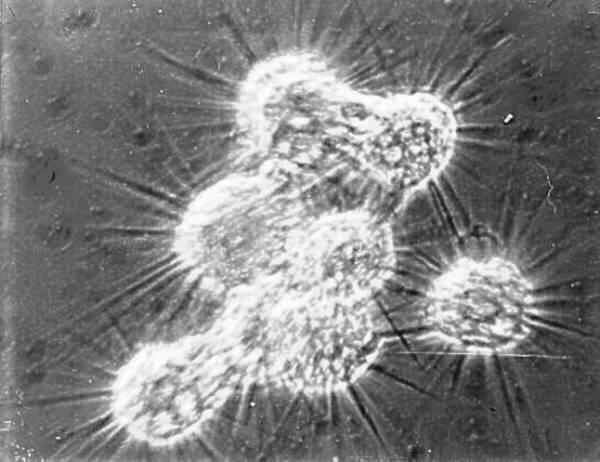
Hypotrichs generally seem to be rather hardy and find ways of adapting to conditions that discourage most other protists which makes them of special interest for environmental studies. Another feature which attracts biologists is their organelles of locomotion which are fused bundles of cilia called cirri. Hypotrichs tend to use them like legs and are often observed crawling along on the substrate even though they can swim.
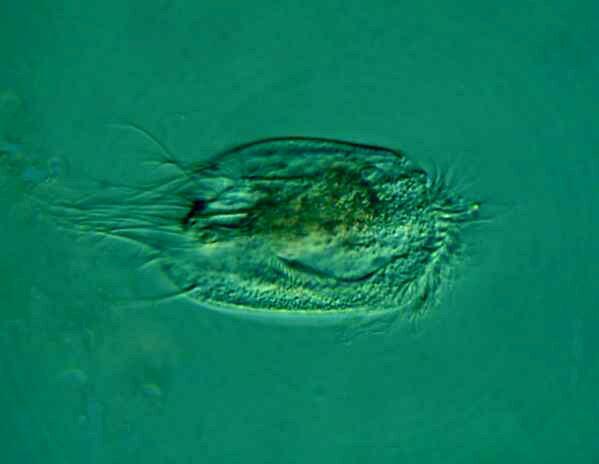
Here you can clearly see the distinctive cirri and the rather tough pellicle. Euplotes, among others, have also been used to study the silverline system of fibrils which occurs in some ciliates.
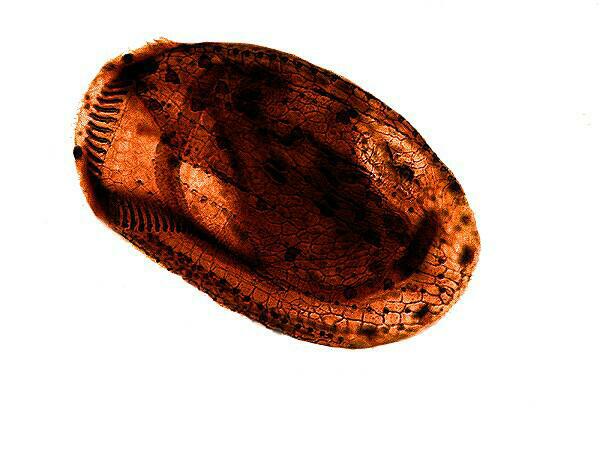
A number of rather elaborate silver staining techniques have been developed to show this network and probably the most elegant results are obtained using the protargol procedures which use an organic form of silver. These techniques are demanding in terms of reagents, equipment, patience, and techniques and only the monomaniacal amateur should even consider attempting them. It is much better for one’s sanity and blood pressure to spend $15 or $20 and purchase a professionally prepared slide.
The amoeba Raphidiophyrs has filose pseudopodia and, at times, a number of these amoebae will gather together to have a picnic and temporarily interlink their pseudopodia to create a sticky net which enhances their ability to capture prey. There are a considerable number of small amoebae that have shown an ability to adapt to a wide variety of conditions that most other organisms would find intolerable. Naegleria fowleri is a classic example; it is an anaerobe. As pollution in ponds and temperatures increase, the old swimming holes of youthful days are no longer safe. As the oxygen-depleted levels in the water column rise, so do the Naegleria. As anyone who has ever swum knows, one expect to swallow a certain amount of water, get it up into ones nose and sinuses, and into ones ears. The stomach acids will take care of the Naegleria, but if you happen to get some in the nasal and sinus (and possibly otic) passages, there may be a serious problem. Naegleria invades the brain and produces a peculiar kind of meningitis. When autopsies have been done on individuals who have been swimming in ponds or pools and have developed meningitis, the results show the brain riddled with Naegleria. And just when you thought it was safe to back into the water again!
At Hutton, there are narrow channels connecting the various lakes and, in one of them, if you time it right, you can swish your dip net back and forth a few times and then bring it up displaying a bright orange color. It will be full of copepods and daphnids. Who knows what they have been feeding on? I would like to know and year after year I have told myself that I would find out, but Supreme Procrastinator of the Universe that I am, I haven’t quite yet gotten around to it.
Hutton Game Reserve is in many ways a harsh environment, but these strange lakes with a marvelous view of snow-capped peaks provide constant challenges to a curious mind.
On the road leading up to Hutton, there are 3 areas that I know of that form temporary ponds when there is sufficient snow melt-off in the spring. Most of the time, however, they simply look like areas of dried, cracked mud, but when the water comes, they suddenly burst with life. These pools only last a few weeks and the moisture triggers a phenomenal population explosion of organisms which have been trapped, sometimes for several years, in the dried mud. These pools are quite shallow and the largest of them is perhaps only 100 feet across. Initially, the arrival of the water produces astonishing growths of tiny algae, flagellates, ciliates, and rotifers and the comes the real marvel–tadpole shrimp, Triops longicaudatus, by the thousands. These bizarre creatures look like a miniature living fossil–a sort of cross between a miniature horseshoe crab (Limulus) and a trilobite.
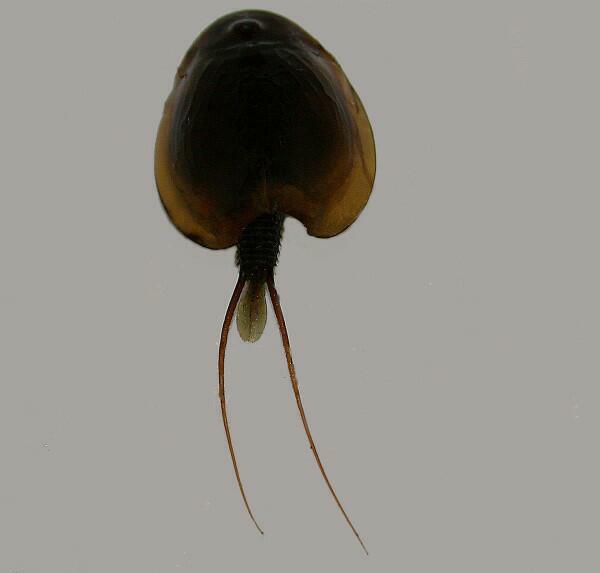
They grow and breed with incredible rapidity and produce astonishing number of highly resistant eggs. It seem to be biologically programmed into them that they have no time to waste. One or two sweeps with a small dip net will produce a net half full of wriggling Triops.
Another set of aquatic environments not to be missed in late spring, summer, and early autumn are to be found in the Snowy Range about 35 miles to the west of us. On the way up, you may find some roadside ditches which have some irrigation overflow or in really good years, some rainwater. Sometimes these have marvelous algal growths and are well worth sampling.
One of my favorite lakes is about half way up the range and it has a name which I once knew and have forgotten, but I don’t feel bad because everyone else I ask–biologists, the Park service, the Forest service–don’t know either. There is vegetation all around it and it is only about 50 feet off the road. Around the edges it is quite shallow and with a pair of mid-calf boots, one can wade out 15 or 20 feet. Here I find lovely balls of Nostoc 2 or more inches in diameter. Below is a glimpse of some of the filaments that constitute Nostoc.
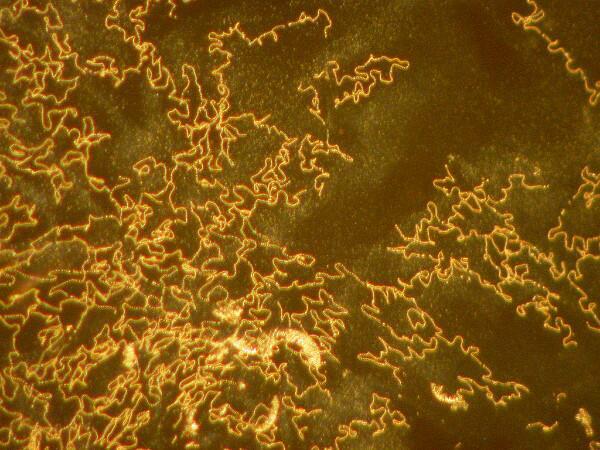
But, it is here that I find a copepod that is ½ to 3/4 of an inch in length and has a magnificent, deep burgundy color. I haven’t found this creature anywhere else. Along the shoreline, sphagnum moss is abundant and full of diatoms, desmids, rotifers, and tardigrades.
Another one of my favorite lakes (whose name I have also forgotten) is the one just before Lake Marie, the lake under Medicine Bow Peak, the highest in the range at 12,013 feet. In October of 1955, a United Airlines flight missed clearing the peak by only a few feet killing 66 people. After the investigation was completed, orders were given to destroy the wreckage that remained on the cliff and napalm was dropped on it. However, even today, fragments of the plane are still found from time to time. Lake Marie is an incredibly cold, deep lake 1,000 feet below the peak. There is relatively little of interest in Lake Marie for the aquatic biologist. The lake just before it is, however, exceptional. Here the snow melts off the peak above it and descends into a bowl full of rocks and small channels that create rivulets that flow into the lake, thus creating lush meadows full of mosses and wildflowers and plenty of places to break an ankle, if you don’t watch where you’re stepping.
Here amongst the mosses of the rivulets and along the shoreline of the lake is a wonderful series of habitats. One finds the usual alpine suspects–rotifers, copepods, dinoflagellates, tintinnids, ciliates, algae, diatoms, desmids, etc. However, what is unexpected and marvelous is an abundance of rhabdocoel flatworms. There are brown ones, orange ones, green ones, purple ones, and even transparent ones in which, under a stereo-dissecting microscope, you can see all of the internal structures. These worms almost look like tiny pieces of glass sculpture with small pieces of stained glass at various points inside, except that these wondrous creatures move and are highly flexible. July and August are the peak months for tourists here in the Snowy Range and so I arm myself with sunscreen and insect spray and head east again to an area called Hidden Valley. I’m sure there’s some history associated with the name, but if I ever knew it, I’ve forgotten it. In the valley, there are some springs which feed streams and the beavers built dams which created some sizeable ponds rich with aquatic fauna and flora. Over the last 20 years, there has been an accumulation of a lot of silt which has encouraged the encroachment of grasses, shrubs, and trees thus drastically reducing the amount of water flow and the size of the ponds. Nonetheless, it can still be a splendid place to collect, if you walk carefully and watch your footing. This is open grazing land and the cattle go to the ponds to get a drink and in areas of soft mud they can create some holes that you really don’t want to step into. It is soft, sticky mud and, on a few occasions, I have been mired up to my mid-thighs. It makes me have a better understanding for those peat bogs in Denmark where they have found the ancient remains of humans, however, apparently most of these people were murdered and then dumped into the sphagnum bogs.
Occasionally one gets to see a beaver, muskrats, a blue racer, lots of chipmunks and squirrels, and dazzling displays of wildflowers including sego lilies, so that even if you forgot to bring along collecting jars, there is nonetheless, much to see and enjoy. I remember one little pool right beside the road which in June could be counted on for enormous numbers of Volvox–a pool now filled with silt and plants. On the underside of logs in the beaver ponds, one could sometimes find colonies of the bryozoan Plumatella repens.
The streams and ponds meander of 10 or 12 miles and then one encounters another set from coming down from the south and another set from the east. For those with mineralogical inclinations, there are outcroppings where one can fine some quite nice quartz crystals and sometimes small fossils–mostly mollusks.
Perhaps my all-time favorite pond is on the other side of this area. Instead of going down into Hidden Valley, one goes north about ½ mile and then turns onto a road which goes up to what is called Pilot Hill. The road is strewn with sizeable rocks and one must proceed alertly and slowly in a high-profile vehicle with 4-wheel drive, although I must admit that 35 years ago, when I was still immortal, I made this trek in a 1966 Volkswagen MicroBus (an appropriate vehicle for a microscopist). The road wanders, but there comes a point when one has to make a sharp right and descend for another quarter of a mile and then make a sharp left and ascend for another quarter of a mile and finally one finds oneself sitting in a lush meadow at the top of a hill and the trail stops. To the right one can descend on foot down a fairly steep incline to my lovely pond. It is a beaver pond fed by a spring. If instead of turning to go up this hill, one continues to descend a bit, you come to a quiet little glade and there nestled in the middle of the grassy glen is a bubbling spring which creates a beautiful little stream with a sandy bottom. It flows on down to create my special pond, with the help of the beavers, of course. Here in a lazy part of the stream I have collected Planaria and, to my surprise, Lacrymaria olor which generally are found in much less oxygen-rich environments. The stream continues downward through grassland bordered by pine and aspen trees and flows into the pond, which is, thanks to the diligence of the beavers, at least 100 feet across and deep enough to support fish. The water flow over the dam is just enough to support another, but much smaller pond surrounded by heavy forest and here the numerous dead leaves support a rich algal growth and I have often found nice populations of Stentor coeruleus. It was in this area that I once found a tiny hummingbird next with two miniature eggs. As I was admiring it, I heard this whirring sound and looked up to see an agitated mother and so I carefully moved away so as not to disturb her any further. Hummingbirds are aerodynamic and aesthetic marvels and, thank goodness, they are now protected by stringent laws.
However, back to my favorite pond. It was here that I first found the elegant bryozoan, Plumatella repens, and my first specimens of Condom humanus. There were also a few specimens of Cani aluminumensis vulgaris. Clearly some previous visitors were highly litterate [sic] which always makes me want to vent my spleen. We should be caretakers of this planet; instead we have become vandals both on an individual level and on a massive corporate scale which fact individuals use to rationalize their “small” transgressions. The cumulative affect of these “small” transgressions sometimes equals or exceeds the disastrous impact of corporate indifference and greed. Enough, well nearly enough. When I’m out in such a splendid place, I pick up as much of the litter as I can and bring it back to dispose of it properly. If I knew who had left it there, they would find it on their front lawns. My Pilot Hill pond is soothing; it is lovely to contemplate and yet full of activity both in the water and in the surrounding landscape. There are prickly pear cacti with their defiant red and yellow blossoms and grasshoppers making buzzing short flight when disturbed and showing their red or yellow wings almost as though they were challenging the cacti. Of course, there are also all of the wonderful aquatic beings engaged in their contests for survival. When the dragonfly nymphs transform into adults to become the Red Barons of the ponds, one can only marvel at their aeronautical maneuvers and, of course, celebrate the fact that they eat lots of mosquitoes. Back in your lab, look at the elegant lattice work of a dragonfly wing.

And then there are the smaller, elegant damselflies, with the bright blue bodies, darting and hovering and, praise be, also eating mosquitoes. Over the last few years as I have reflected and written about my collecting adventures, I have come to realize how much I love this area, even with its pernicious, unpredictable climate. When I comes time for me to die, I shall miss this strange, marvelous, sad and splendid planet–except for the mosquitoes!
All comments to the author Richard Howey are welcomed.
Editor's note: Visit Richard Howey's new website at http://rhowey.googlepages.com/home where he plans to share aspects of his wide interests.
Microscopy UK Front
Page
Micscape
Magazine
Article
Library
Please report any Web problems or offer general comments to the Micscape Editor .
Micscape is the on-line monthly magazine of the Microscopy UK website at Microscopy-UK .